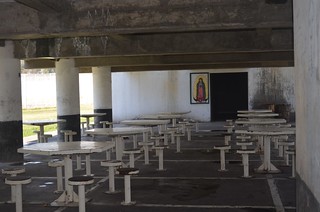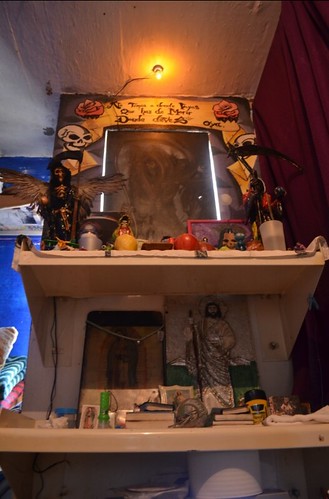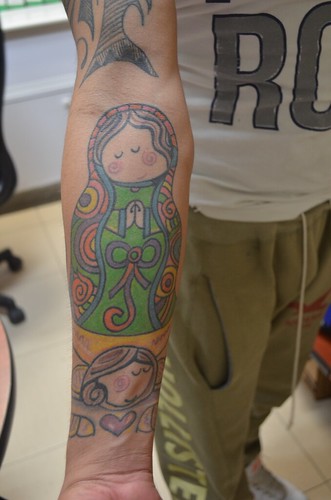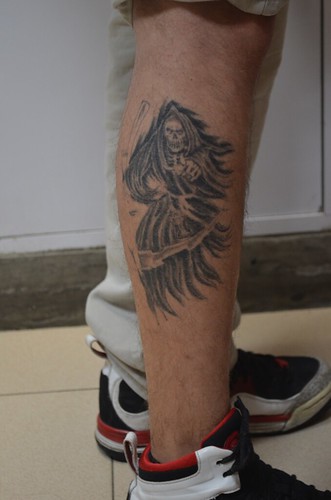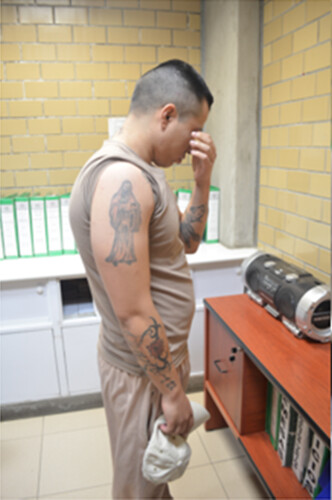The altars of the body as resistance to prison power
- Jorge Adrián Yllescas Illescas
- ― see biodata
The altars of the body as resistance to prison power1
Reception: March 8, 2017
Acceptance: June 19, 2017
Abstract
This text is part of an investigation carried out at the Santa Marta Social Reintegration Center in Mexico City, the main objective of which was to learn about the practice of the cult of “Santa Muerte” in that prison institution. Various themes emerged from this proposal, and one of them was the use of the body and its relationship with religious practices in a context where control is omnipresent. It will first examine what this prison control consists of and then the importance of the body as a form of resistance to said prison power will be considered.
Keywords: altars, body, prison, endurance, Holy death, tattoos
The body's altars as resistance to prison power
The present essay describes selected research performed at the Santa Marta Men's Social-Reinsertion Center in Mexico City, whose main object was to understand Santa Muerte religious practices at that correctional facility. The proposal gave rise to a number of issues including the use of the body and the body's relationship to religious practices, in a context where control is ubiquitous. The nature of this prison-related control is revealed to then posit a thesis on the importance of the body as a means of resisting prison-related power.
Keywords: Santa Muerte, prison, body, tattoos, altars, resistance.
Introduction
The cult of Santa Muerte is one of the religious phenomena whose expansion and diffusion has been constant since the first decade of this century in Mexico and has even reached the United States; it positioned itself as one more offer in the Mexican religious market.
The cult has been the subject of different investigations that have tried to answer the origin of these beliefs, but always starting with the symbol of death and its transformation in our culture (Malvido, 2005; Lomnitz, 2006; Perdigón, 2008). Other research has tried to explain some social processes that have allowed Santa Muerte to have so many followers and to be expanding in various parts of the country (Fragoso Lugo, 2007; Kristensen and Adeath, 2007; Castells Ballarin, 2008; Reyes, 2010).
Something that has not gone unnoticed in this cult are its devotees and the characteristics of the socio-cultural sector to which many of them belong. Among the various studies that have directly or indirectly addressed the subject of Santa Muerte, the relationship between this numen and the prison population has been captured (Lerma, 2004; Payá, 2006; Payá, 2006; Payá, 2006). et al., 2013) or who have family members who have been imprisoned (Kristensen, 2011, 2015; Fragoso Lugo, 2007).
Only in Mexico City, from 1992 to 2005 the prison population has increased considerably, and so have the street altars of Santa Muerte, whose number increased especially in places such as Nezahualcóyotl, Ecatepec, Atizapán de Zaragoza, Chimalhuacán. "Those altars were also in areas with high levels of violence and large prison populations."2 (Kristensen, 2011: 551).
The prison system has a number of ambiguities, such as corruption within the justice system. Many of the prisoners are usually detained before being investigated and during inquiries; that is, in "the process" they spend at least six months in jail. Some are incarcerated without guilt, or serve long sentences for minor offenses. Faced with this type of situation, Santa Muerte appears, who rewards and punishes, a sacred figure as ambiguous as the justice apparatus is often. Many of the interns,3 According to Regnar, they approach Santa Muerte asking her to speed up the procedures to obtain a sentence and leave the uncertainty of the prison process.
So far only some investigations have indirectly addressed the issue of the presence of Santa Muerte inside the prison. The sociologist Víctor Alejandro Payá finds that, within prisons, death and the devil are worshiped (2006: 243). On the other hand, an investigation that was carried out in a women's prison explains how, in the daily life of the confinement, some inmates had magical beliefs, among which was that of Santa Muerte:
The inmates believe in it as a refuge, especially because, they say, it is the only one that "fulfills whims", and that is that being in a place full of uncertainty, where liminality absorbs and living is like being dead, believing in the Holy Death is clinging to those who do understand them (Lerma, 2004: 128).
This article takes up part of a broader investigation (Yllescas, 2016) carried out at the Santa Marta Center for Men's Reintegration, in Mexico City, whose main objective was to know how the cult of Santa Muerte was practiced in a space of seclusion. Among the results of this investigation, it was possible to observe the way in which the inmates use their bodies as a form of resistance to the prison power, marking themselves by means of tattoos different symbols that mostly refer to religious and family issues. In addition, the body becomes an altar or ritual deposit that allows inmates to establish a connection with the sacred. One of the rules in jail is that, in there, you just have to see, hear and be quiet.
The prison (jail, tambo, boat, cane are some names that it receives) is without a doubt a controlling institution. To quote Foucault, who from his theoretical proposal defines the prison as an omnidisciplinary institution, it is “an exhaustive disciplinary apparatus. In several senses: it must deal with all aspects of the individual, with their physical education, their aptitude for work, their daily behavior, their moral attitude ”(Foucault, 2005: 235). It represents a confined space where specific interactions of a disciplinary nature take place.
Similarly, the prison can be understood as a total institution, which Goffman defines as
a place of residence and work where a large number of individuals in the same situation, isolated from society for an appreciable period of time, share in their confinement a daily routine, formally administered (2007: 13).
Among such institutions he distinguishes at least five types: those that serve to care for harmless people, such as homes for the elderly; those who care for people who cannot care for themselves and are an unintended threat to society, such as psychiatric hospitals; A third type of total institution is organized to protect the community against those who intentionally constitute a danger to it, and prisons belong to this type; another group of institutions are deliberately destined to the best fulfillment of a work-related task, and finally mentions the establishments conceived as shelters of the world.
The sociologist thus classifies total institutions by the similarity they have in their interaction dynamics; in prisons are those who are "intentionally" dangerous and who are not guaranteed well-being. Among its characteristics are the break with ordinary activities (sleeping, playing, working, eating) that subjects normally carry out outside without any authority that mediates them, while in total institutions these activities are subject to authorities, programmed with a rational plan to be executed; furthermore, they are carried out in the same place and under the same authority. The daily activity of the members of the institution is carried out in the immediate company of a large number of others, who receive the same treatment and who are required to do the same things, together.
Another key characteristic of total institutions is the bureaucratic apparatuses charged with managing the needs of the institution's inmates. Among the bureaucracy are the people in charge of surveillance. These personnel are not in charge of giving orientation or making periodic inspections of the people in their charge, but rather of
see that everyone does what they have been clearly told to be required of them, under conditions in which an individual's violation would likely stand out in singular relief against the background of general, visible and proven subjection (Goffman, 2007: 20).
In other words, there is a submissive group, that of inmates, and a small group of personnel who manage them and who are the supervisors.
The inmates live inside and have limited contacts with the world beyond the walls of the total institution, while the rest of the (bureaucratic) staff work short hours and constantly go outside. Inmates and staff often represent each other with rigid stereotypes,
staff often judge inmates as cruel, traumatized and untrustworthy; inmates often view staff as petulant, despotic, and petty. Staff tend to feel superior and fair; the inmates to feel inferior, weak, reprehensible and guilty (Goffman, 2007: 21).
Communication between both strata is regularly restricted and is carried out with special tones of voice; information is often limited between the two, especially staff plans regarding inmates; contact restrictions help maintain stereotypes.
The work activity is programmed by the bureaucratic part of the institution; In this sense, the incentive to work lacks the meaning it has outside, which is why different attitudes and motivations towards work are generated on the part of the inmates; This situation can lead to the little work that is required leading to boredom among inmates, since work can be slow and with minimal payments, but there are also total institutions in which “more than an ordinary day of heavy work is required, and to encourage compliance, rewards are not offered but threats of physical punishment ”(Goffman, 2007: 23).
Another control that total institutions have over inmates lies in their family relationships. Contact with the family is controlled and even programmed. But it is also important that inmates have contact with their families and thus withdraw from the total institution, it is a guarantee of permanent resistance against total institutions. In general, Goffman says that “the total institution is a social hybrid, part residential community and part formal organization” (2007: 25), and therefore it is important for sociological and anthropological analysis.
In the research, it was very important to take this theoretical perspective into account, because it addresses the role that religiosity has around Santa Muerte in a total prison-type institution, from the perspective of the spaces of the staff and the spaces of the internal In this way, it is possible to understand how the inmates appropriate their spaces, putting altars or religious images in their cells or in the corridors, applying a different rationale to that of the prison staff, who have designed the spaces of the prison with other functions. internal
In total institutions such as prisons, all activities are organized and controlled by the bureaucratic apparatus or the staff. Religious practices are not beyond that control, since the staff who run the prison establish norms so that they can be carried out or not. Although in the discourse of legality and the rights that each person has, it is established that everyone is free to practice a religion or not to practice any, within prisons this freedom is usually respected but with some restrictions.
In the Men's Center for Social Reintegration there are two chapels within the spaces of common use, one Catholic and one Protestant, where family recreation activities are carried out or for inmates to try to change and reflect on their behavior. The prison staff recognizes as a good practice a notable change in the behavior of those inmates who carry out activities in both the Catholic and Protestant Church.
In both chapels religious acts are celebrated, there is reading of the Bible, even in the Catholic chapel spiritual retreats are organized. Or in the case of the Protestant, pastors come from different places to help the inmates. However, not all prisoners attend the chapels for reasons of faith, but for the benefits that they can achieve both in their sentence record and in more immediate terms, since they can receive food or cleaning products, which are not easy. to get inside the prison.
On the other hand, in the case of inmates who carry out other religious practices, such as that of Santa Muerte, they are prohibited from mounting altars or putting effigies in public spaces within CEVARESO. The places to practice the cult of Santa Muerte or the devil and Santeria are the cells and corridors, spaces whose access is not public and are kept hidden from the view of relatives and other authorities. It is a way of covering up within the prison this type of religiosity, which is part of a negative stigma because they are considered to be typical of inmates who have not changed their criminal behavior.
The control of religious expressions in prison is very clear, since Catholic religious images or symbols are allowed to be placed in open spaces, such as dining rooms.
Although prison staff try to establish a control system for all inmate activities, in reality this system has its limits; for example, there are spaces in which inmates live on a daily basis, such as their cells; there are prisons whose habitable spaces are designed for five or six inmates, but in reality up to twenty people live in them, which gives rise to disputes and very unique forms of accommodation in these small spaces, and that inmates generate their own alternatives to inhabit them.4
In CEVARESO there is no such problem of room in the cells; there, a cell designed for five inmates usually has five inmates. There is even an area of individual cells where the prisoners who have “good behavior” and who have shown “improvements” are. Inside the cells it is possible to corroborate which inmate has money and which does not, since some have televisions, mattresses, shelves; that is to say that although the spaces are thought and designed for a certain form of coexistence, the inmates make their own adjustments and leave their identity marked.
The body as resistance
As you walk through the corridors and cells of CEVARESO you can see different murals, many of them have Santa Muerte as their central figure, others the devil, Catholic saints, and many are only names of some inmates who were there. In this way it is that the prisoners appropriate the jail, resorting to images with which they identify or that represent their longing for freedom.
In the murals, the religious figures appear accompanied by their devotees, either by means of the outline of a body or with the mark of the name; In addition, figures that refer to chance are usually painted, such as dice, since they live in constant uncertainty; They also refer to the heaviness of time in prison, depicting figures of elephants or clocks on the murals.
Inside the cells the inmates usually put altars filled with figures of different materials and accompanied by murals with the figure of the saint; This activity is a form of resistance to prison control, since these spaces were originally designed to place personal belongings, such as clothing, and the inmates appropriate them with their religious beliefs and practices.
In addition to the murals in the corridors and the altars on the shelves is the body of the inmates, which enters the same dynamic of resilience, since
it becomes a privileged territory for institutional action. The captive body is the property of the State and its challenge is to catch it; desiring body, in continuous movement, always on the verge of uproar and transgression, so it will always be a target to be overcome (Payá, 2006: 271).
Although in reality the body of the inmates is not totally controlled, and it becomes one of the limits of power and prison control, since “the body is a signified reality” (Augé, 1998: 64) with a characterized individuality by the experiences and individual physiognomies with which the inmates are differentiated and individualized by embedding symbols through tattoos, which become part of the body, personifying it and giving it a sense of autonomy.
In this way, the inmates decide where on their body to put the tattoo, the figures they prefer according to their belief or personal history. Through the ink marks on the skin, the inmates recall their life in freedom or with the family, in them they capture the experiences inside the jail, and also through tattoos they express their faith.
Although the use of tattoos is a very common practice, not all inmates are tattooed, but a good percentage are.5 The most frequent images are mostly religious images such as the Virgin of Guadalupe, the Christs, crosses, devils, Santa Muerte. Or there are also tattoos of human faces, names of people, significant dates, psychedelic figures, famous phrases, among many others.
Tattoos vary in their shapes, sizes and the part of the body where they are placed, be it the back, the face, the neck, the shin, the calf, the arms, the pectorals, the hands, the fingers. The sizes vary between the very small - such as those made on the fingers - and the very large, which cover the entire back or arm.
In the case of religious practices, tattoos become a means that links the wearer with his numen. Through them, the inmates can protect themselves from an evil or can invoke it, embody the pacts with their beliefs and give them identity. But that identity is not precisely one that alludes to belonging to a group, rather it is one that is born from a personal decision, so
The choice of drawing responds above all to a personal initiative and an aesthetic preference, it is not a gesture of adhesion. The link with the cosmos can exist, metaphorically, only if the individual's story articulates it through a symbolism that only belongs to him (Le Breton, 2013: 46).
The altars of the body
In prison the bodies of inmates adorned with religious tattoos are similar to altars.6Because like ritual deposits, religious tattoos are placed on the body with a specific function and rationality. Just as objects are deposited on an altar, placed and safeguarded for a specific purpose, ink is placed on the body to commemorate faith; both are means to create a link with the sacred.
The altars are assigned a physical space to carry out all kinds of ritual practices. In the body of the devotee one of its parts is destined to place the tattoos, which later serve for the ritual.
The altars serve to display the religious preferences of each devotee and each of the objects that are placed there has a significant history for those who assemble and protect them. In a similar way, the body becomes an altar, since the believers put their tattoos many times to be exhibited and show through them their religious ascriptions. The religious tattoo has a significant history for the wearer. The inmates embody their beliefs through their religious tattoos and through them they seek to feel the sacred in their body, and this becomes a devotional vehicle.
In some interviews with inmates they were asked about their tattoos, and when they discussed the meaning or history of their tattoo, they did so while touching or caressing it, directing their hand and gaze towards it. The body gesture was like that of the protection of something of value, with subtle movements of the hands and the sight, as if they remembered something.
Some of the tattoo stories referred to a pact or promise that the prisoners made with Santa Muerte, such as the inmate known as “el Gato”. He, apart from working in a commission within CEVARESO, was also dedicated to the sale and arrangement of figures of Santa Muerte made of papier-mâché. "The Cat" had many tattoos. He knew Santa Muerte from a young age in Oaxaca, thanks to an aunt; "El Gato" conceives of Santa Muerte as a beautiful woman, a virgin who gave her flesh for the good of a child and that is how she was left with only the skeleton.
The Saint helped him to accompany his brother during his agony, who was evicted. "El Gato" made a promise to Santa Muerte that if she let him out of prison in the United States so that he could see his brother die he would get a tattoo, in his request he told her that if he wanted to, he would return him to a prison later of the death of his brother, and for that reason, he assures, is that now he is locked up again.
In prison he makes figures of Santa Muerte that he sells among the inmates themselves, he also makes them on request to sell them outside. "El Gato" also knows how to paint, he even painted one of the murals of Santa Muerte that are in the corridors. He says that selling the Santas Muertes is a way to earn money at CEVARESO, and that way it also helps him. He has already had to be “bitten” in a fight, and he says that he was saved by Santa Muerte. Another of the miracles he did was to see his dad again after several years.
A: And do you have tattoos of the Saint?
G: From the Godmother I have… They are all incomplete.
A: why? Where do you get them?
G: In jail, most of them here.
A: But who makes them for you?
G: Yo, all these here I did.
A: How do they do it? Are there tattoo machines ...?
G: No, but you get one.
A: How do you do it?
G: Well, with a radio motor or by hand, you just grab the needles ...
A: What ink is it?
V: Well, from pens… I know how to paint.
A: And have you drawn those?
G: They are the graves of my brother, my friend, this means jail, these are ...
A: What is the jail?
G: The one with the chains. And here I have, if you realize, this one; I was tattooing things that I did as a kid, when I did not know that it was tattoos because it is also culture, like art, and here I have the meaning, the graves of my brothers, my friend, and the skulls of people I have known I wear them in skull shapes and here I have the Godmother dressed as if she were the Virgin of Guadalupe, she means life and death. I have the last name Rosario, this cross is the cross, you see that it has a skull in the middle, all the others, just like these, are pure skulls, but I wanted to tattoo it, because in this part of here it is incomplete, I will to show: the person behind is not the Virgin of Guadalupe, it is the Virgin of Fatima, the one who supposedly is Death before being like that.
A: To get a tattoo here, you, for example, say that with your machines, but if not, does the other charge to do them or are they favors between you?
G: No, because between us when we scratch, sometimes, "do this to me and I'll do this to you." In exchange for things, as they did before, a barter.
A: In total, how many tattoos do you have?
G: Skulls I have seven and here I am doing it in the rib to below the waist. They are like nine.
(Interview Adrián Yllescas, February 2015.)
The tattoos of Santa Muerte, in addition to representing the pacts that the inmates make with her, also function as amulets, since they feel protected; Another of their functions is that they remember a difficult event. For example, Paredes' tattoos helped him not to be intimidated when he entered CEVARESO. Upon welcoming him, the prisoners were going to beat him, and when they saw that he had the Santa Muerte tattoo they did nothing to him.
A: Has that tattoo been of any use to you, for something here?
P: No, well yes, right? Pretend that a lot of band here does walk envelopes, but I mean, I'm normal with my shirt. When I got to the beginning "Get him, fucking, what's up, let's see, what are you bringing?" And then, just when they do this (turn their arm) they see the image, they see it and "Chale carnal, open up, go throw a role", another one passes that has no image and does not bring protection. "You get to him, what can you do, you don't bring, why not?", They strip them, they begin to train them: "Let's see, give me some chocolates." (Interview, Adrián Yllescas, February 2015.)
In conclusion
It was observed how religious practices within the prison are in some way controlled, both those of those institutional religions whose function is to contain and control inmates through strict disciplines, in order to correct the prisoners who decide to join them. religious activities that aim to guide and help inmates through the teachings of God. Those institutional religions serve as means of institutional control.
On the other hand, other belief systems, such as that of Santa Muerte, serve as forms of resistance against the prison power, since the prisoners appropriate the spaces to express this type of beliefs and are free to carry them out in accordance with their own possibilities.
The body also serves to express resistance to prison control through tattoos, which are a way of embodying beliefs. The inmates make their body an altar, in which they draw memories, experiences and symbols that give them identity on their flesh, and it becomes a means of connection and bonding with their sacred entities. Tattoos on the body are a way of showing that they cannot be completely stripped away, that they are still linked to the outside, although that outside can only be constantly remembered through an ink drawing on their skin.
Bibliography
Augé, Marc (1998). Dios como objeto. Símbolos-cuerpos-materias-palabras. Barcelona: Gedisa.
Castells Ballarín, Pilar (2008). “La Santa Muerte y los derechos humanos”, LiminaR. Estudios Sociales y Humanísticos, año 6, vol. vi, núm. 1, junio.
Fragoso Lugo, Perla (2007). “La muerte santificada. La fe desde la vulnerabilidad: devoción y culto a la Santa Muerte en la ciudad de México”. Tesis de maestría en antropología social. México: CIESAS.
Foucault, Michel (2005). Vigilar y castigar. Nacimiento de la prisión. México: Siglo XXI.
Goffman, Erving (2007). Internados. Sobre la situación social de los enfermos mentales. Buenos Aires: Amorrortu.
Lerma Rodríguez, Enriqueta (2004). “Ritos institucionales e instituyentes y creencias mágicas en el Centro Femenil de Readaptación Social de Tepepan”. Tesis de licenciatura en sociología. México: fes-Acatlán.
Kristensen, Regnar (2011). Postponing Death. Saints and Security in Mexico City. Universidad de Copenhagen, Departamento de Antropología, Facultad de Ciencias Sociales. PhD Series núm. 68.
— (2015). “La Santa Muerte in Mexico City: The Cult and its Ambiguities”. Journal of Latin American Studies, 47, pp.543-566.
— y Caludia Adeath (2007). La Muerte de tu lado. México: Casa Vecina, colección Libros de la Meseta.
Le Breton, David (2013). El tatuaje. Madrid: Casimiro.
Lomnitz, Claudio (2006). La idea de la Muerte en México. México: fce.
Malvido, Elsa (2005). “Crónicas de la Buena Muerte a la Santa Muerte en México”, Arqueología Mexicana, vol. XIII, núm. 76, noviembre-diciembre, pp. 20-27.
Payá, Víctor (2006). Vida y muerte en la cárcel. Estudio sobre la situación institucional de los prisioneros. México: Plaza y Valdés/unam-Facultad de Estudios Superiores Acatlán.
— (coordinador), Grissel López, Jovani Rivera y Quetzalli Rojas (colaboradores) (2013). Mujeres en prisión. Un estudio socioantropólogico de historias de vida y tatuaje. México: Juan Pablos Editor/unam-Facultad de Estudios Superiores Acatlán.
Perdigón Castañeda, Katia J. (2008). La Santa Muerte protectora de los hombres. México: inah.
Reyes Ruiz, Claudia (2010). La Santa Muerte. Historia, realidad y mito de la “niña blanca”. México: Porrúa.
Rivera, Jovani (2011). Cuerpo y ritualidad moderna: inscripciones corporales en mu- jeres prisioneras. Tesis de licenciatura en Sociología. Ciudad de México: Facultad de Estudios Superiores Acatlán, unam.
Yllescas Illescas, Jorge Adrián (2016). “La Santa Muerte: historias de vida y fe desde la cárcel”. Tesis de maestría en en Antropología, México, UNAM-FFYL/IIA.


